SSSHA Simplified : The Legal Contract Every Startup Founder Must Master
The Ultimate Legal Backbone of Startup Funding Deals
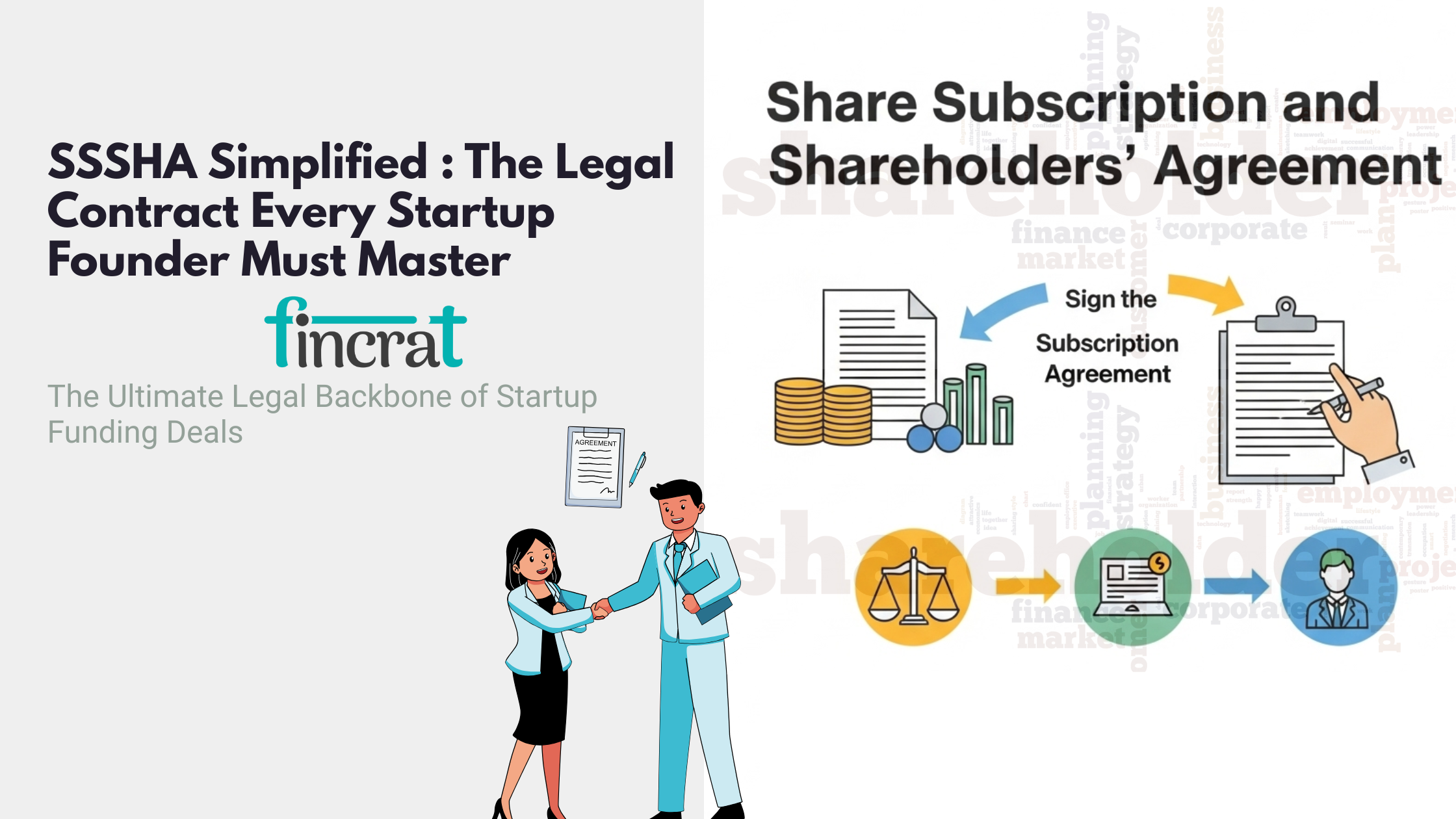
When a handshake deal turns into a signed term sheet, the real work has just begun. What truly seals the funding round is not the pitch, not the valuation—but the Share Subscription and Shareholders’ Agreement (SSSHA). This legally binding contract governs how equity is issued, how decisions are made, and what rights every shareholder—especially investors—will hold.
In this guide, we’ll break down:
- What the SSSHA is
- Why it matters in startup funding
- Its core purpose
- Key components and clauses
- Types of SSSHA based on funding stages
- Final Thoughts: Don’t Sign Blindly
What Is SSSHA?

- Legal contracts in startup financing are official, legally binding documents that spell out the rights, duties, and obligations of both the investors and the founders of the startup following an agreed investment arrangement.
- The most significant among them is the SSSHA, short for Share Subscription and Shareholders' Agreement. It consolidates two fundamental agreements:
- Share Subscription Agreement (SSA) – Describes conditions under which investors commit to subscribe (purchase) fresh shares in the company.
- Shareholders' Agreement (SHA) – Describes how the company shall be governed, run, and shareholder rights safeguarded.
- Cumulatively, the SSSHA is the legal underpinning of the investment agreement.
- Typical SSSHAs are 20–50 pages long, depending on the deal's complexity.
- The legal agreements process involves the completion of the Share Subscription and Shareholder's Agreement (SSSHA), which defines the responsibilities and rights of both investors and the startup.
- This legally binding agreement regulates items such as voting rights, ownership of equity, and exit routes.
- Legal Protection: Clear legal agreements provide protection for both founders and investors in the event of disagreements or conflicts.
- Clarity: Clear legal terms bring peace of mind and prevent future disagreements regarding ownership, decision-making, and exit situations.
- The SSSHA will usually contain pre-emption rights, vesting schedules, and liquidation preferences.
- Legal fees to draft these agreements range from $5,000 to $15,000 based on complexity.
- More than 50%-60% of startups state that ambiguous legal rights among shareholders caused internal conflicts in subsequent stages.
Why the SSSHA Matters in Startup Funding
A signed SSSHA is much more than legal formality—it’s a cornerstone of investor trust and operational clarity. Here's why:
- Clarity & Legal Safeguards: Ensures both parties are clear on rights, duties, and expectations.
- Prevents Future Disputes: Clearly outlines exit strategies, control mechanisms, and shareholding structure.
- Investor Confidence: Institutional investors typically demand a signed SSSHA before transferring funds.
- Compliance & Professionalism: A proper SSSHA is a hallmark of a professionally run startup, critical for future rounds and due diligence.
Purpose of SSSHA (Share Subscription and Shareholders’ Agreement)
The purpose of the SSSHA is to legally define the terms of investment and the relationship between the investors and the founders after a funding round. It brings clarity, control, and protection for all parties involved.

- To Legally Formalize the Investment Transaction : The Share Subscription section of the SSSHA stipulates the number of shares an investor is subscribing to, at what price, and under what terms.It legally formalizes the investment transaction, ensuring capital as well as equity are transferred appropriately.
- To Establish Shareholder Rights and Responsibilities : The Shareholders' Agreement section lays down roles, duties, voting rights, and safeguards for every shareholder—guaranteeing transparency and governance, particularly for minority investors.
- To Safeguard the Interests of Both Founders and Investors : Through provisions dealing with exit options, drag-along/tag-along rights, liquidation preferences, and anti-dilution protections, the SSSHA guarantees that both founders and investors are safeguarded against future legal or financial disputes.
- To Align Long-Term Goals:It has provisions such as founder lock-in, vesting, and performance milestones that keep founders locked-in and the startup aligned with investor expectations.
- To Enable Future Fundraising and Compliance : A well-drafted SSSHA makes future funding rounds, due diligence, and audits easy and provides a foundation for corporate governance and investor trust.
- To Avoid Conflicts : Well-delineated obligations, rights, and conflict resolution frameworks prevent misunderstandings and expensive lawsuits down the road.
Structure of the SSSHA: Key Components
Let’s explore the essential building blocks of the SSSHA.
1.Subscription Terms (SSA Portion)
- Amount invested
- Number and class of shares to be issued
- Price per share
- Closing date for investment
2. Capitalization and Shareholding (Cap Table)
- Post-investment updated cap table
- Impact of dilution
- Voting rights split
3. Governance and Board Structure
- Board structure (who receives board seats)
- Voting rights
- Decision-making thresholds (e.g., majority, supermajority)
4. Investor Rights
- Information Rights: Right to financial reports, updates, etc.
- Inspection Rights: Right to audit or inspect company books.
- Preemptive Rights: Right to join in future funding to preserve equity.
5. Founder Restraints
- Vesting of Shares: Founder equity can vest over 3–4 years to guarantee long-term commitment.
- Lock-in Period: Founders can be prohibited from selling shares for a specified duration.
- Non-compete and Non-solicit Clauses
6. Exit Clauses
- Drag-Along Rights: Majority shareholders can compel minority shareholders to sell if there's a buyer.
- Tag-Along Rights: Minority shareholders can sell their shares if the majority shareholder sells his.
7. Liquidation Preferences
- Sets payout priority in case of company sale or closure (e.g., 1x or 2x of investment size).
8.Anti-Dilution Protection
- When shares are subsequently issued at a lower price, early investors are shielded against over-dilution.
9. Transfer of Shares
- Restrictions on share sale to third parties
- Rights of first refusal (ROFR) for current shareholders
10. Dispute Resolution
- Jurisdiction and legal procedure for settlement of shareholder disputes
- Arbitration clauses
- Example: A startup enters into an SSSHA in which the investor can buy more shares when other shareholders are selling so that they can retain their stake.
Key Clauses in Startup Investment Agreements
1. ROFR (Right of First Refusal)
- This provision gives current investors or the company the right to purchase shares first if a shareholder wishes to sell.
- So that they can maintain control over the ownership and prevent unwanted third-party investors.
- Example: When a founder intends to sell shares to a non-shareholder, existing investors can match the bid and buy those shares first.
2. Drag-Along and Tag-Along Rights
- Drag-Along Rights: Permit majority shareholders (usually investors) to compel minority shareholders to sell out if a full company buyout occurs.
- Guarantees that a buyer will be able to buy 100% of the company without opposition.
- Tag-Along Rights: Safeguard minority shareholders by permitting them to participate in a sale made by majority shareholders.
- Avoids minority holders being left behind during a liquidity event.
3. Exit Clauses
- These stipulate how and when investors can exit their investment.
- IPOs, acquisitions, buybacks, or secondary sales.
- Provides investors with transparency about how they can achieve returns on their investment.
- Example: An investor can have the right to request a buyback after 5 years if no exit is realized.
4. Anti-Dilution Protection
- Prevents investors from losing equity ownership when new shares are sold at a lower valuation (down round).
Types:
- Full Ratchet: Updates the investor's price per share to the lower valuation.
- Weighted Average: More friendly to founders; averages the effect based on share quantity.
- Preserves fair value for early investors.
5. Founders' Responsibilities and Vesting
- Describes what founders are obligated to do and establishes vesting timelines for their shares.
- Responsibilities: Full-time work, performance objectives, governance responsibilities.
- Vesting: Earning of shares over time (e.g., 4 years with a 1-year cliff).
- Helps founders remain committed and connected with long-term company success.
6. Confidentiality and Non-Compete Provisions
- These keep founders or employees from:
- Revealing sensitive information (Confidentiality).
- Launching or becoming part of competing businesses (Non-Compete).
- To protect the startup's intellectual property and market position.
7. Dispute Resolution
- Describes how disagreements between shareholders or between investors and founders will be resolved.
Choices:
- Mediation
- Arbitration (usual for quicker, private resolution)
- Court litigation
- Decreases legal risks and enables more efficient management of future disputes.
Types of SSSHA (Share Subscription and Shareholders’ Agreement)Based on Funding Rounds
Here are the main types or variations of SSSHA commonly seen in startup funding:
- Seed-Stage SSSHA
- Pre-Series A / Bridge Round SSSHA
- Series A SSSHA
- Series B & Later-Stage SSSHA
- Down-Round or Restructuring SSSHA
- Exit-Stage SSSHA
1. Seed-Stage SSSHA
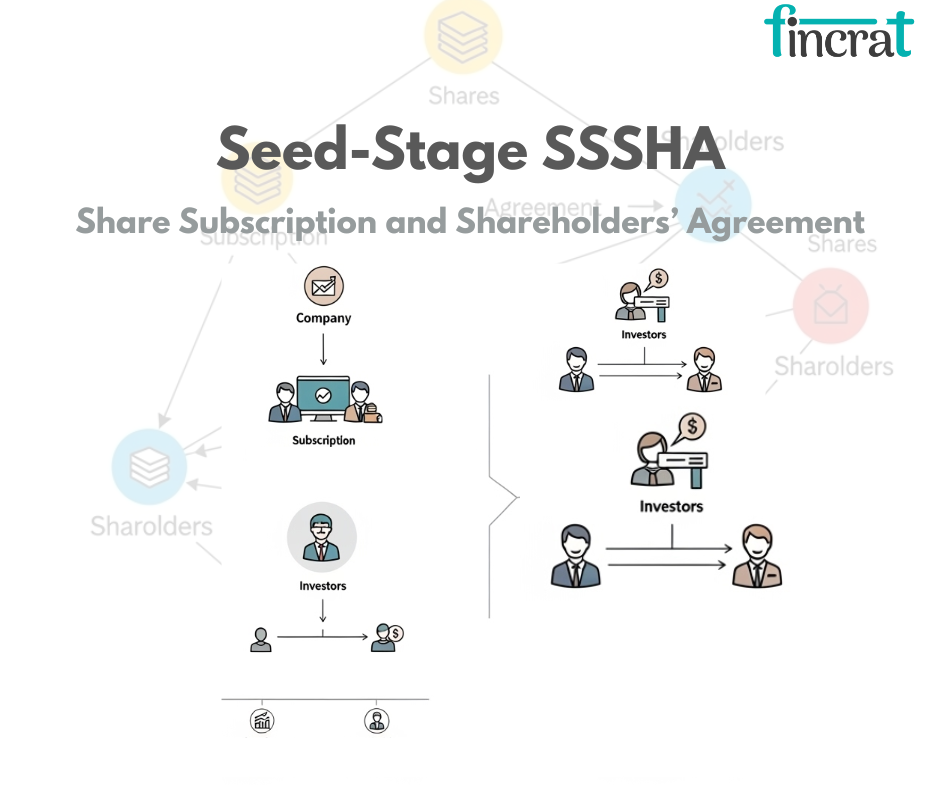
- In the seed stage, the SSSHA generally reflects straightforward investment arrangements, whereby a minimum of angel investors or family and friends are involved.
- Simple clauses in regard to the foundation such as equity distribution, general governance, and pre-emptive rights are in the focus.
- These contracts generally provide founders with greater control but continue to safeguard initial investors with provisions of Right of First Refusal (ROFR) and general anti-dilution protections.
- Legal sophistication is minimized to lower cost and time, but vesting, founder obligations, and exit rights must be clear.
2. Pre-Series A / Bridge Round SSSHA
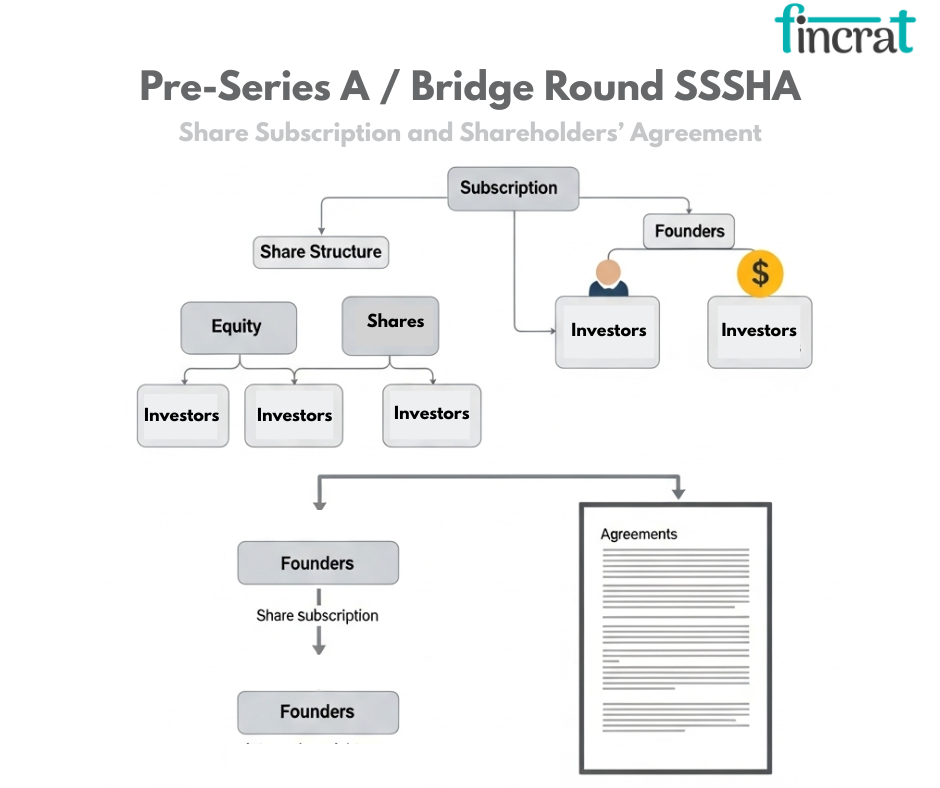
- This form of SSSHA may contain convertible instruments (e.g., SAFE notes, convertible debentures) or discounted equity agreements.
- The provisions start to incorporate more institutional expectations, such as a more defined ESOP structure and early investor rights like pro-rata participation and observer seats on the board.
- These SSHA contracts span informal early deals and more formal venture capital terms, setting up both startup and investor for more organized financing rounds to come.
3. Series A SSSHA
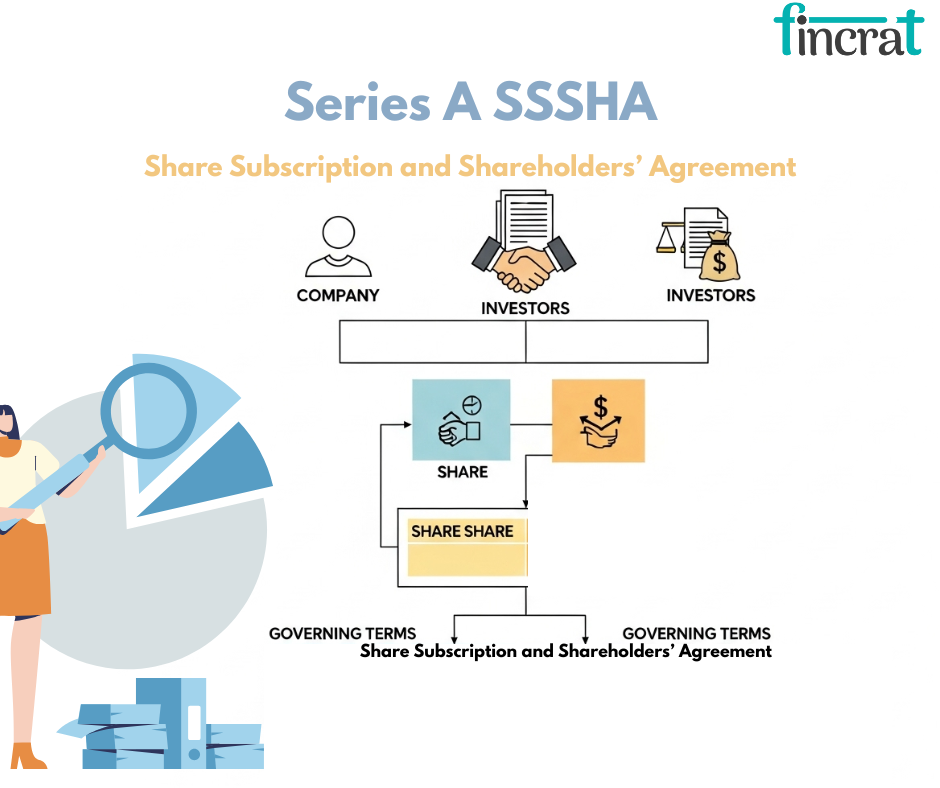
- At this point, the SSSHA becomes much more formalized and investor-friendly since venture capitalists (VCs) tend to come in on this round.
- More serious bargaining occurs in terms of key provisions like liquidation preference, voting rights, drag-along rights, and anti-dilution protection.
- Series A documents usually establish the legal and operational tone for subsequent rounds, including board composition, reserved matters, ESOP growth, and veto rights on key decisions.
- Legal due diligence and enforceability become critical, and founders can expect more aggressive clauses.
4. Series B & Later-Stage SSSHA
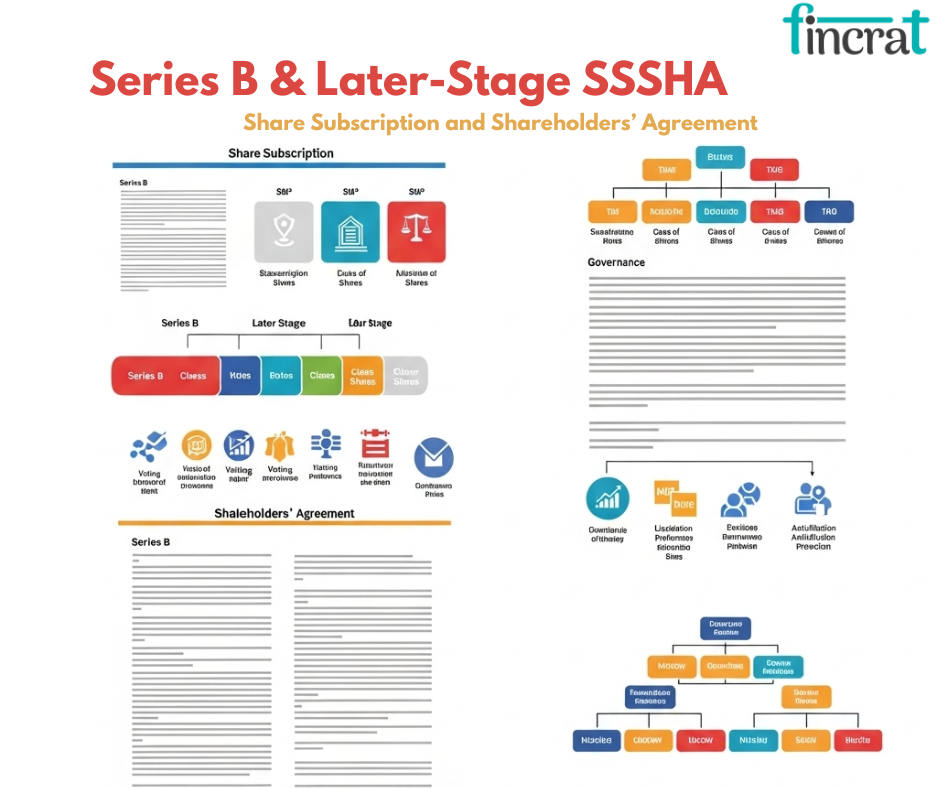
- In Series B and later, the SSSHA is even stronger and more layered.
- These contracts must be able to handle multiple classes of stock, distinct sets of investor rights, and complicated ownership structures.
- Later investors can negotiate senior liquidation preference, multiple board positions, greater information rights, and structured exit strategies.
- Prior investors can have variant rights compared to new entrants, and controlling the interaction of these provisions becomes legally complex.
- These types of agreements will usually need to be redrafted previous SSSHA iterations to fit within the growing cap table and governance requirements.
5. Down-Round or Restructuring SSSHA

- In situations where the company is raising capital at a lower value than previously (a down round) or experiences financial restructuring, the SSSHA requires specific provisions to deal with anti-dilution provisions, reset ESOPs, and resettle control rights.
- These arrangements are more favorable to new investors but may dilute previous stakeholders.
- Deliberate legal terminology is employed to reconcile investor optimism and founder incentives, frequently with provisions such as weighted-average anti-dilution and full-ratchet adjustments.
6. Exit-Stage SSSHA

- In the case of an exit round—e.g., an acquisition or pre-IPO—the SSSHA is converted into a transaction-level agreement that dictates the selling of shares, proceeds distribution, and what rights persist or expire post-exit.
- Final drag-along execution, liquidation waterfalls, and investor right termination are some of the key clauses.
- It further specifies confidentiality, terms not to compete after leaving, and conflict resolution processes if any dispute occurs during the exit process.
Final Thoughts: Don’t Sign Blindly
The Share Subscription and Shareholders’ Agreement (SSSHA) is far more than a formality—it’s the strategic blueprint that governs ownership, control, and eventual exits in your startup.
It ensures alignment between founders and investors, protects everyone’s interests, and sets the foundation for scalable, dispute-free growth.
That’s why you should never rush through it, never skim over clauses, and absolutely never sign without thorough legal review. What seems like “just paperwork” today can define the fate of your company tomorrow.
"In startup law, what you don’t read can cost you millions—so don’t just sign, scrutinize."

